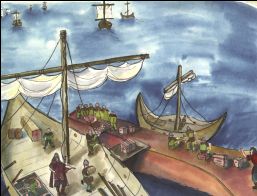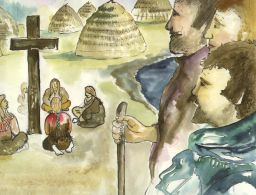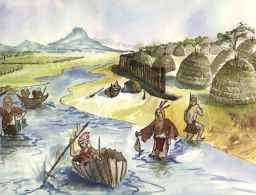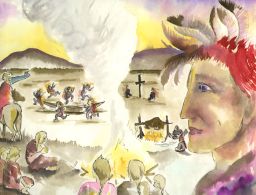

Illustrations by Rachel Crittenden
Beneath the shadow of the Cathedral in Bangor lies in peace the body of Owain Gwynedd, the greatest Prince of Wales. But immediately apon his death in 1170 there was fierce rivalry between the many sons of his many wives, fighting for supremacy over North Wales from the River Dovey to the River Dee.
In the first battle (at Pentraeth on the Island of Anglesey) the first brother (a poet and a warrior) was cut down, and the remaining sons of Owain forged a treaty to divide the mountainous land between them.
One of the younger sons, however, was Madoc the Bold, a brave and daring adventurer who cared little for the pleasures of land or wealth - his passion was for the sea.
Prince Madoc decided to leave his fractious brothers and to sail away in search of the legendary Fountain of Youth. His two ships, the Gwennan Gorn and the Pedr Sant, were built of sturdy oak from ancient forest trees, and instead of iron the nails were of stag's horn to protect the crafts from the fatal attraction of magnetic islands.
From a small harbour at the mouth of the River Ganol on the north coast of Wales, Prince Madoc and his men put out to sea, sailing west into the sunset and leaving Ireland far behind to the north.
After many days Prince Madoc returned to Wales, spinning fisherman's yarns of deep and dangerous waters where ships became entangled in a garden of yellow seaweed, of huge fish that got away, and of a strange but fruitful country where the native people had red skins and black hair.
Then the Prince and his brother Rhiryd, Lord of Clochran, collected together such men and women as desired to try a new life, and they set sail from the Island of Lundy in ten small ships to establish a Welsh colony in an unknown land.
Nothing more was seen or heard in Wales of Prince Madoc and his ships until Colombus re-discovered America 300 years later. The Spanish reported with surprise that some of the natives were already worshipping the Christian Cross.
Later explorers discovered an unusual tribe of blue-eyed Red Indians living on the banks of the Missouri. Their skin was fair, and their hair was blonde, red or brown.
These Indians called themselves Mandans. They peppered their language with Welsh words and fished from boats made round like the coracles of Wales. They told how their tribe had once dwelt at the mouth of three rivers on the Gulf of Mexico, from where they had made the long trek north to the Knife River on the Upper Missouri.
The Welsh Indians lived in settlements built on rocky outcrops which resembled the hillforts of Britain. Their lodges looked like beehives and were made of timber plastered thick with earth. These huts were grouped into large villages defended by palisades, ramparts and ditches, and each village was surrounded by regular patterns of fields growing crops.
The Mandans treasured most highly the possession of blue glass beads - the kind of beads used in trade by seamen from the Island of Lundy. And every village harboured a 'holy canoe' made out of red cedar around which rituals and ceremonial dances were performed. This shrine was dedicated to the Lone White Man, who had brought the Mandans in his big canoe from across the great water.
* THE END *





